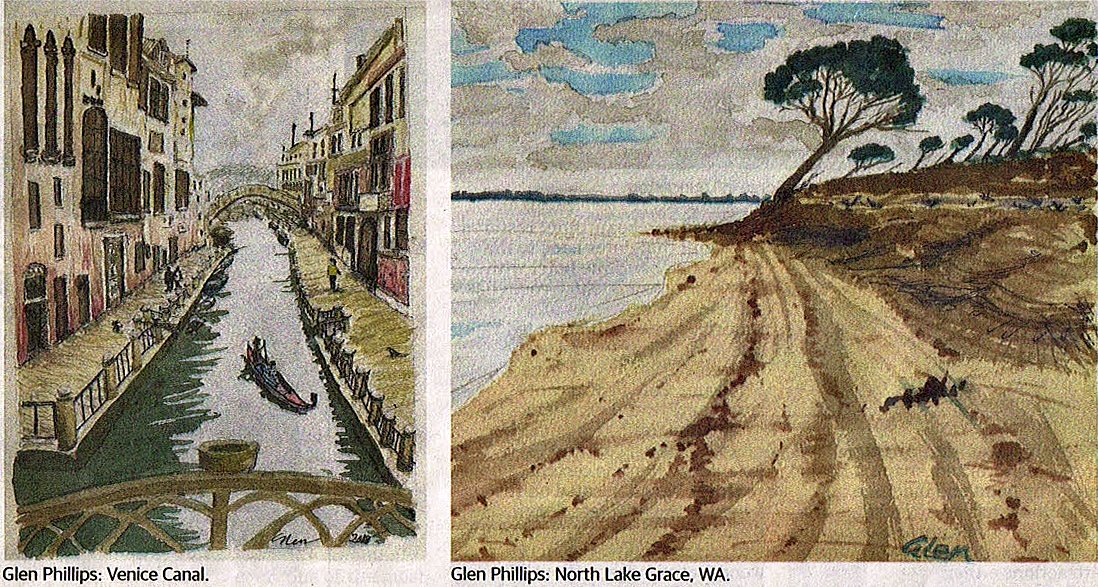and a long-term resident of Mount Lawley
Prolific West Australian poet, artist and academic Professor Glen Phillips’ first experience of watercolour painting was in a little outback town when he was in the final years of primary school. His ‘school’ would be extended to the surrounding “wheat fields and tree-lined roads”. “Apart from drawing pictures of cars in my school exercise books during adolescence, I have always felt attracted to painting landscapes, mainly country landscapes,” Glen says.
“As a pre-schooler, I wandered free among bush trees and shrubs while my betters were reciting their lessons in a nearby school. Even at night I listened for the noise of the wind in the trees around our outback houses, the sound of the rain on a tin roof or bird songs, especially at dawn or dusk.” The weekend drives with the family “to see farms, forest and lakes” opened up the country to him. He felt compelled “to stop and paint those landscapes”. This was his “second lesson, a lesson of discovery”.
BACK TO THE BEGINNING
Glen recalls that the pre-school teacher who started it all was an ex-Canadian air force pilot: “One day he suggested we go out into the school grounds with our paintboxes and sketch something that appealed to us. I chose a tall white-gum that towered over the school roof.” It was the beginning of Glen’s lifetime love affair with drawing and painting.
His brother, who was studying to be an art teacher, encouraged him to pursue his passion. Alas, other “serious” academic pursuits would take precedence over art. “I was keen to gain a scholarship to study at high school and had to divert my energies to improving my maths and other school subjects,” he says. “Sketching became an occasional pastime for relief from the intensity of my high school studies.”
Despite never having had another art lesson, Glen would continue to draw and paint. His facility was quite apparent. In 1951, by which time he was living in Perth, a teacher encouraged him to enter the Claude Hotchin Art Award for schoolchildren.“I was lucky enough to win a ‘highly commended’ for my painting of a local brickworks, including its tall chimney,” he says. The painting was acquired by the Claremont Teachers College for its art collection.
BACK TO THE FUTURE
Fast-forward to 2022 and we find the well-travelled Glen presenting his watercolour exhibition Half a Hundred at Mt Lawley ECU’s Gallery25. Showing from January 11-21 , the exhibition opening on January 19 will also include the launch of Glen’s latest collection of poems and paintings, 100 Landscapes of Australia, Italy and China.
The retiring dean of ECU’s school of arts and humanities, Professor Clive Barstow, will be opening the exhibition and launching the book. “Although better celebrated for being a prize-winning poet, Glen as a painter reveals a striking affinity with the many and varied landscapes he depicts in this, the first of his and the first of ECU’s 2022 gallery exhibitions,” he said. I love Glen’s drawings and watercolours for their delicacy of line and hue, for their compositional subtlety and judicious use of foreground, middle ground and background.
All of which recall the topographical curiosity of Australian colonial and settler watercolours as much as Chinese and Japanese aesthetics. Whether it’s a row of houses in Jianjiang Street, or rice stubble, in China, an Italian alpine village, a gorgeous echidna or Busselton Jetty and Lake Grace closer to home, it’s Glen’s sensitivity to nature and landscape in particular which comes to the fore.
Ars longa, vita brevis, as they say. Art is long, life is short. There is not a moment to waste. And Glen has made the most of it.
Copyright © 2022 The West Australian
Published Sunday Times 9 January 2022


